Check answers here:
Chapters 11 – 12: BGP Exam Answers
Quiz-summary
0 of 36 questions completed
Questions:
- 1
- 2
- 3
- 4
- 5
- 6
- 7
- 8
- 9
- 10
- 11
- 12
- 13
- 14
- 15
- 16
- 17
- 18
- 19
- 20
- 21
- 22
- 23
- 24
- 25
- 26
- 27
- 28
- 29
- 30
- 31
- 32
- 33
- 34
- 35
- 36
Information
CCNP ENCOR v8 Chapters 11 – 12: BGP Test Online
You have already completed the quiz before. Hence you can not start it again.
Quiz is loading...
You must sign in or sign up to start the quiz.
You have to finish following quiz, to start this quiz:
Results
0 of 36 questions answered correctly
Your time:
Time has elapsed
You have reached 0 of 0 points, (0)
| Average score |
|
| Your score |
|
Categories
- Not categorized 0%
- 1
- 2
- 3
- 4
- 5
- 6
- 7
- 8
- 9
- 10
- 11
- 12
- 13
- 14
- 15
- 16
- 17
- 18
- 19
- 20
- 21
- 22
- 23
- 24
- 25
- 26
- 27
- 28
- 29
- 30
- 31
- 32
- 33
- 34
- 35
- 36
- Answered
- Review
-
Question 1 of 36
1. Question
1 pointsWhat TCP port is used by BGP to exchange messages between routers?Correct
Incorrect
Hint
BGP routers exchange messages reliably over TCP using port 179. -
Question 2 of 36
2. Question
1 pointsRefer to the exhibit. Autonomous system 65500 is routing traffic between two external BGP autonomous systems, autonomous system 65200 and autonomous system 65100. Synchronization is disabled on BGP in autonomous system 65500. Which routers should have IBGP peer relationships for routing between autonomous system 65200 and autonomous system 65100 to work properly?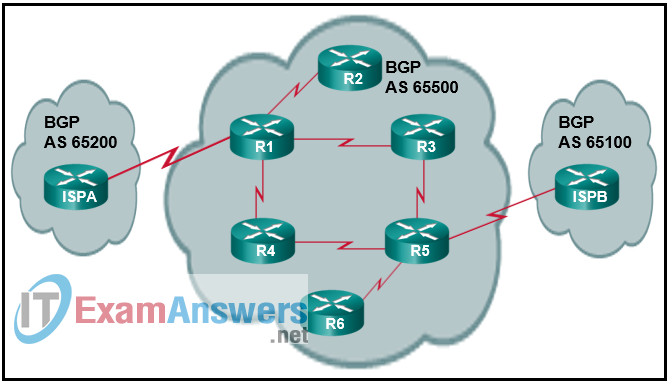 Correct
Correct
Incorrect
Hint
Within the BGP AS 65500, because synchronization is disabled within the AS, IBGP should be used to establish peer relationships to provide routing service within the AS. R2 and R6 represent subnetworks. Static route and default route configuration provide adequate network access. -
Question 3 of 36
3. Question
1 pointsWhat type of BGP message precedes the successful formation of a BGP peering session?Correct
Incorrect
Hint
A BGP open message is used to establish a BGP adjacency. Both peer sides negotiate session capabilities before BGP peering is established. -
Question 4 of 36
4. Question
1 pointsQuestion as presented: Match the values to AFI and SAFI extensions supported by MBGP. (Not all options are used.)Correct
Incorrect
Hint
To expand the support for multiple network layer protocols to original BGP-4, RFC 2858 added Multiprotocol BGP (MBGP/MP-BGP) capability by adding an extension called the address family identifier (AFI). An address family correlates to a specific network protocol, such as IPv4 or IPv6, and additional granularity is provided through a subsequent address family identifier (SAFI) such as unicast or multicast. -
Question 5 of 36
5. Question
1 pointsWhat is the order in determining the BGP router ID?Correct
Incorrect
Hint
Statically configuring the BGP router ID (RID) is a best practice to ensure RID stability. If the RID is not statically configured, the dynamic RID allocation logic uses the highest IP address of any active loopback interfaces. If there is not an active loopback interface, then the highest IP address of any active interfaces becomes the RID when the BGP process initializes. -
Question 6 of 36
6. Question
1 pointsRefer to the exhibit. A network administrator is configuring BGP on a router. Which configuration step is needed in order to establish the BGP session with the neighbor router?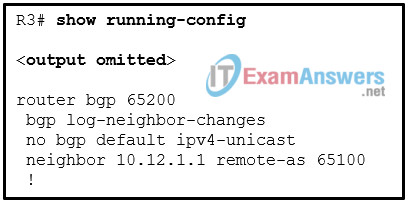 Correct
Correct
Incorrect
Hint
For a BGP session to initiate, one address family for a neighbor must be activated. On Cisco routers the IPv4 address family is activated by default; however, it may cause confusion when working with other address families. The BGP router configuration command no bgp default ip4-unicast disables the automatic activation of the IPv4 AFI. -
Question 7 of 36
7. Question
1 pointsRefer to the exhibit. Which two configurations will allow router R1 to establish a neighbor relationship with router R2? (Choose two.) Correct
Correct
Incorrect
Hint
To configure EBGP, the router bgp command is followed by the AS number in which the router resides. Conversely, the neighbor command contains the AS number to which the remote router belongs. -
Question 8 of 36
8. Question
1 pointsWhich BGP routers will become peers and share routing information?Correct
Incorrect
Hint
In BGP configuration, the BGP router configuration command neighbor ip-address remote-as as-number is used to identify the IP address and autonomous system number associated with the BGP neighbor. -
Question 9 of 36
9. Question
1 pointsWhich two statements describe the configuration differences when MP-BGP is applied using the IPv6 protocol compared to IPv4 protocol? (Choose two.)Correct
Incorrect
Hint
The BGP configuration rules in IPv4 apply to IPv6, except that the IPv6 address family must be initialized, and the neighbor is activated. Routers with only IPv6 addressing must statically define the BGP RID to allow sessions to form. -
Question 10 of 36
10. Question
1 pointsA network administrator is configuring IPv6 route summarization on a BGP router. The objective is to aggregate the IPv6 networks from 2001:db8:0:0::/64 to 2001:db8:0:35::/64 into a single summary route. Which aggregation command should be used for the task?Correct
Incorrect
Hint
The fourth hexadecimal of the IPv6 network 2001:db8:0:35::/64 is 0x35 that is equivalent to binary notation of 00110101. Thus 6 bits is the least needed for the purpose of route summarization. -
Question 11 of 36
11. Question
1 pointsRefer to the exhibit. What is used to exchange routing information between routers within each AS?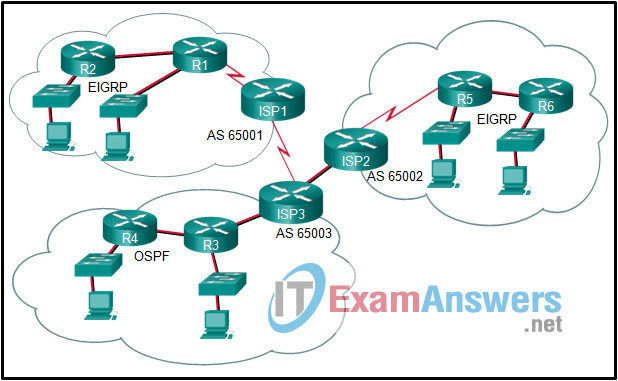 Correct
Correct
Incorrect
Hint
IGP routing protocols such as EIGRP and OSPF are used within an organization to exchange routes. An EGP routing protocol such as BGP is used to route traffic originating within one AS to the rest of the Internet (other individual autonomous systems). -
Question 12 of 36
12. Question
1 pointsRefer to the exhibit. A network administrator is configuring BGP on a router. What network layer protocol and function are enabled for the BGP session?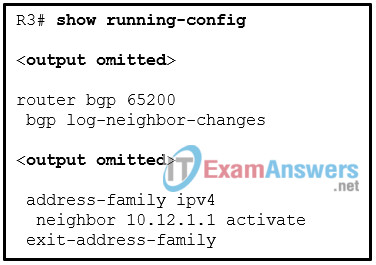 Correct
Correct
Incorrect
Hint
The address family is initialized by using the BGP router configuration command address-family afi safi . On IOS and IOS XE devices, the default subsequent address family identifier (SAFI) for the IPv4 and IPv6 address families is unicast and is optional. -
Question 13 of 36
13. Question
1 pointsWhich BGP state is the one where BGP initiates the TCP connection and sends an Open message to the sender?Correct
Incorrect
-
Question 14 of 36
14. Question
1 pointsWhich BGP attribute includes a complete list of all the ASNs that the prefix advertisement has traversed from its source AS?Correct
Incorrect
-
Question 15 of 36
15. Question
1 pointsRefer to the exhibit. For which autonomous system would running BGP not be appropriate?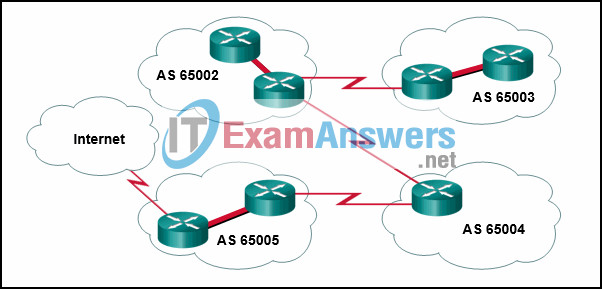 Correct
Correct
Incorrect
Hint
It is appropriate to use BGP when an autonomous system is multihomed, or has more than one connection to another autonomous system or to the Internet. BGP is not appropriate for single-homed autonomous systems. Autonomous system 65003 is a single-homed AS because it is only connected to one other autonomous system, 65002. -
Question 16 of 36
16. Question
1 pointsA company is deploying BGP multihoming to provide internet connection redundancy. Which method can be used to avoid the internet transit routing situation?Correct
Incorrect
Hint
If an enterprise uses BGP to connect with more than one service provider, it runs the risk of its autonomous system (AS) becoming a transit AS. Because BGP uses path cost to select best path, a path through the internal BGP routers might appear with a better path cost, hence the risk of local AS providing transit routing to everyone in the internet. Transit routing can be avoided by applying outbound BGP route policies that only allow for local BGP routes to be advertised to other autonomous systems. -
Question 17 of 36
17. Question
1 pointsRefer to the exhibit. Which statement describes the condition when the BGP route-map TEST permit 40 command is processed and what is the result of processing?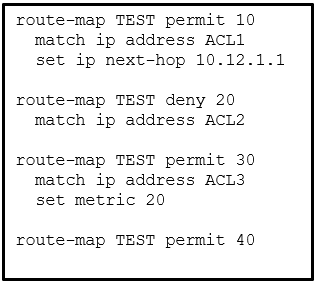 Correct
Correct
Incorrect
Hint
A route map uses the command syntax route-map route-map-name [ permit | deny ] [ sequence-number ]. The rules that apply to route map statements are as follows: If a processing action is not provided, the default value permit is used. If a sequence number is not provided, the sequence number is incremented by 10 automatically. If a matching statement is not included, an implied all prefixes is associated with the statement. Processing within a route map stops after all optional actions have processed and after matching a conditional matching criterion. -
Question 18 of 36
18. Question
1 pointsA company is deploying BGP multihoming to provide network connection redundancy for several branch locations. One of the network design objectives is to provide deterministic routing among company locations during failover by providing a specific location to handle branch transit traffic. Which two design criteria should be applied to the specific facility? (Choose two.)Correct
Incorrect
Hint
Multihomed environments should be configured so that branch routers cannot act as transit routers. In most designs, transit routing of traffic from another branch is undesirable, as WAN bandwidth may not be sized accordingly. If transit behavior is required, it should be restricted to the data centers or specific locations with these design criteria: Proper routing design can accommodate outages. Bandwidth can be sized accordingly. The routing pattern is bidirectional and predictable. -
Question 19 of 36
19. Question
1 pointsA network administrator is configuring a prefix list with the ip prefix-list command. What is the best practice in dealing with the sequence number in creating a prefix list?Correct
Incorrect
Hint
Prefix lists are configured with the global configuration command ip prefix-list prefix-listname [ seq sequence-number ] { permit | deny } high-order-bit-pattern / high-order-bit-count [ ge ge-value ] [ le le-value ]. Because prefix lists cannot be re-sequenced, it is advisable to leave enough space for insertion of sequence numbers at a later time. -
Question 20 of 36
20. Question
1 pointsA network administrator is configuring a prefix list with the commandipv6 prefix-list IPV6-1 seq 5 permit 2001:db8:abcd:30::/60 ge 61 le 63
Which two networks match the prefix match specification? (Choose two.)Correct
Incorrect
Hint
The prefix matching logic works the same for IPv6 networks as for IPv4 networks. The fourth hexadecimal group of the match specification is 0x0030, which is 00000000 00110000 in binary. To match /60 prefix length, the fourth hexadecimal group of a network must be between 00000000 00110000 and 00000000 00111111, that is, between 0x0030 and 0x003F. The prefix length must be between /61 and /63. -
Question 21 of 36
21. Question
1 pointsQuestion as presented: Match the route map component to the description. (Not all options are used.)Correct
Incorrect
Hint
A route map has four components:- Sequence number: Dictates the processing order of the route map.
- Conditional matching criteria: Identifies prefix characteristics (network, BGP path attribute, next hop, and so on) for a specific sequence.
- Processing action: Permits or denies the prefix.
- Optional action: Allows for manipulations, depending on how the route map is referenced on the router. Actions can include modification, addition, or removal of route characteristics.
-
Question 22 of 36
22. Question
1 pointsRefer to the exhibit. Considering the route map configuration for BGP, which statement describes the condition for a network prefix to match the route map TEST ? Correct
Correct
Incorrect
Hint
In route map configuration, if there are multiple variables (ACLs, prefix lists, tags, and so on) configured for a specific route map sequence, only one variable must match for the prefix to qualify. The Boolean logic uses an OR operator for this configuration. The processing action is performed only after a match occurs. -
Question 23 of 36
23. Question
1 pointsWhich BGP state is the one where BGP waits for a KEEPALIVE or NOTIFICATION message from a neighbor so that the BGP session can be moved to Established?Correct
Incorrect
-
Question 24 of 36
24. Question
1 pointsWhich three statements describe the weight attribute for BGP? (Choose three.)Correct
Incorrect
Hint
BGP weight is a Cisco-defined attribute and the first step for selecting the BGP best path. Weight is a 16-bit value (0 to 65,535) assigned locally on the router; it is not advertised to other routers. -
Question 25 of 36
25. Question
1 pointsWhich BGP attribute can be configured on IBGP speakers so they will choose a desired path out of the autonomous system to an outside network?Correct
Incorrect
Hint
The local preference attribute indicates the preference for exiting the AS to the destination network. The local preference is not advertised between eBGP peers and is typically used to influence the next-hop address for outbound traffic (that is, leaving an autonomous system). Local preference can be set for specific routes by using a route map or for all routes received from a specific neighbor. A higher value is preferred over a lower value. -
Question 26 of 36
26. Question
1 pointsA network administrator is configuring a prefix list to match networks for BGP route filtering. Which two networks match the prefix match specification 10.224.0.0/12 ge 24 le 28 ? (Choose two.)Correct
Incorrect
Hint
Prefix lists provide another method of identifying networks in a routing protocol. A prefix list identifies a specific IP address, network, or network range and allows for the selection of multiple networks with a variety of prefix lengths by using a prefix match specification. A prefix match specification contains two parts: a high-order bit pattern and a high-order bit count, which determines the high-order bits in the bit pattern that are to be matched. The high-order bit pattern is also known as the network address and the high-order bit count as the mask length. The network portion of the matching networks is 10.224.0.0 and higher. The mask length of the matching networks must be greater than or equal to /24 and less than or equal to /28. -
Question 27 of 36
27. Question
1 pointsRefer to the exhibit. A network administrator is troubleshooting BGP configuration and wants to display only routes that originated in AS 40. Which regular expression should the administrator use in the command show bgp ipv4 unicast regex regex-pattern ?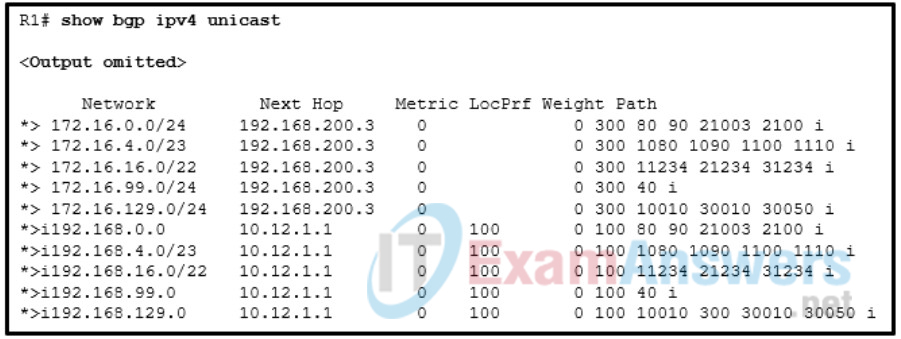 Correct
Correct
Incorrect
Hint
In troubleshooting BGP, regular expressions (regex) can be used to parse through the large number of available ASNs. Regular expressions are based on query modifiers used to select the appropriate content. The regex pattern 100_ indicates to only include the lines that contain the exact phrase of 100. Some regex query modifiers are as follows: (underscore) – Matches a space ^ (caret) – Indicates the start of a string $ (dollar sign) – Indicates the end of a string . (period) – Matches a single character, including a space -
Question 28 of 36
28. Question
1 pointsWhich two statements describe private BGP communities? (Choose two.)Correct
Incorrect
Hint
Private BGP communities follow a particular convention where the first 16 bits represent the AS of the community origination, and the second 16 bits represent a pattern defined by the originating AS. A private BGP community pattern can vary from organization to organization, does not need to be registered, and can signify geographic locations for one AS while signifying a method of route advertisement in another AS. -
Question 29 of 36
29. Question
1 pointsRefer to the exhibit. Given the above configuration commands, which two statements are true? (Choose two.) Correct
Correct
Incorrect
Hint
Route summarization on BGP edge routers via dynamic method is configured by specifying an aggregation network prefix. The aggregate-address command advertises the aggregated route (the supernet) in addition to the specific original component network prefixes. By using the optional summary-only keyword, the component network prefixes in the summarized network range are suppressed. When a BGP router summarizes a route, it does not advertise the AS_Path information from before the aggregation. This effect is indicated by the atomic aggregate attribute. The atomic aggregate attribute indicates that a loss of path information has occurred. -
Question 30 of 36
30. Question
1 pointsRefer to the exhibit. A network administrator issues the show bgp ipv4 unicast command to check the routes in the BGP table. What does the indication of 0.0.0.0 under Next Hop mean? Correct
Correct
Incorrect
Hint
As the BGP prefix is installed into the Loc-RIB table, the following BGP PAs are set, depending on the RIB prefix type:- Connected network : The next-hop BGP attribute is set to 0.0.0.0, the BGP origin attribute is set to i (IGP), and the BGP weight is set to 32,768.
- Static route or routing protocol : The next-hop BGP attribute is set to the next-hop IP address in the RIB, the BGP origin attribute is set to i (IGP), the BGP weight is set to 32,768, and the MED is set to the IGP metric.
-
Question 31 of 36
31. Question
1 pointsA network administrator is configuring route summarization for received routes before advertising to the next peer with the commands:R1(config)# router bgp 65500 R1(config-router)# aggregate-address 172.16.0.0 255.255.240.0 as-set summary-only R1(config-router)# end
How will the aggregate route be advertised after the commands are entered?Correct
Incorrect
-
Question 32 of 36
32. Question
1 pointsWhich BGP state is the one where an Open message has been sent from the originating router and is awaiting an Open message from the other router?Correct
Incorrect
-
Question 33 of 36
33. Question
1 pointsRefer to the exhibit. A network administrator is configuring BGP route filtering on R1. The objective is to advertise only locally originated routes to its neighbor to avoid undesirable transit connectivity. Which AS path ACL should the administrator configure?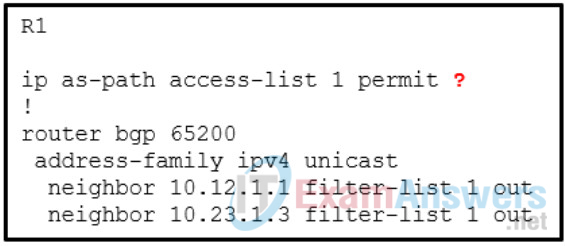 Correct
Correct
Incorrect
Hint
To restrict traffic to only locally originated traffic, configure the AS path ACL using the regex pattern ^$. -
Question 34 of 36
34. Question
1 pointsA network administrator is configuring an ACL to match networks for BGP route filtering. The administrator creates an ACE permit ip 10.0.64.0 0.0.63.0 255.255.255.0 0.0.0.192 . Which two networks match the ACE? (Choose two.)Correct
Incorrect
Hint
One method for conditional matching of routes in BGP is through extended ACLs. When extended ACLs are used for this purpose, the source fields match against the network portion of the route, and the destination fields match against the network mask. The network portion of the matching networks is 10.0.64.0 through 10.0.127.0. The network mask portion is /24 through /26. -
Question 35 of 36
35. Question
1 pointsRefer to the exhibit. A network administrator is troubleshooting BGP configuration and wants to display only routes with AS 300 being the first AS in the AS_Path value. Which regular expression should the administrator use in the command show bgp ipv4 unicast regex regex-pattern ?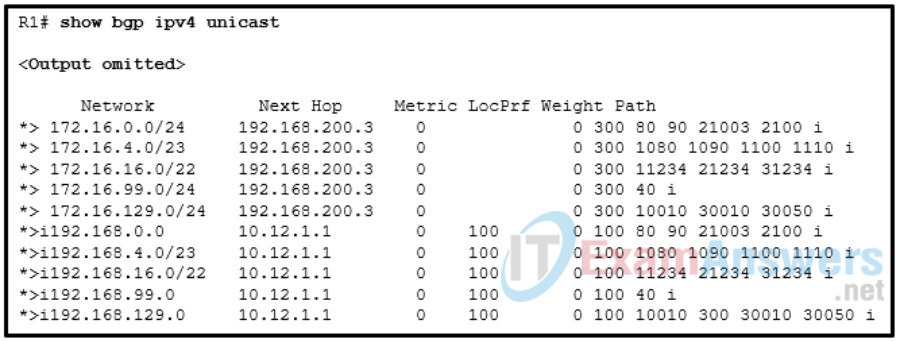 Correct
Correct
Incorrect
Hint
In troubleshooting BGP, Regular expressions (regex) can be used to parse through the large number of available ASNs. Regular expressions are based on query modifiers used to select the appropriate content. The regex pattern ^300_ indicates to only include the lines that list the exact phrase of 300 as the first AS. Some regex query modifiers are as follows: _ (underscore) – matches a space ^ (caret) – indicates the start of a string $ (dollar sign) – indicates the end of a string . (period) – matches a single character, including a space -
Question 36 of 36
36. Question
1 pointsWhich BGP message is sent when an error is detected with the BGP session causing the BGP connection to close?Correct
Incorrect
Hint
A Notification message is sent when an error is detected with the BGP session, such as a hold timer expiring, neighbor capabilities change, or a BGP session reset is requested. This causes the BGP connection to close.

In question 27 the “correct” answer (regex: ^40_) would match all the networks whose last AS is 40, not the networks originating on AS 40.
Question 32, the correct answer is OpenSent (B). Exstart is not a neighbor state in BGP, but in OSPF.
Question 34 should be multiple choice.
can you please tell the correct answer to ques 32
Which BGP state is the one where an Open message has been sent from the originating router and is awaiting an Open message from the other router?
how come exstart is the answer when this state is not even present in bgp?
reponse OPENSEN